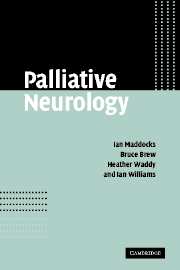Book contents
- Frontmatter
- Contents
- Foreword
- Note on drugs and abbreviations
- Section I Palliative Management
- Section II Major discomforts in advanced neurological illness
- 1 Fatigue
- 2 Problems with muscles and movement
- 3 Bulbar symptoms
- 4 Respiratory symptoms
- 5 Gastrointestinal symptoms
- 6 Urological symptoms
- 7 Pain
- 8 Cognitive, behavioural and psychological symptoms
- 9 Miscellaneous symptoms
- Section III Major neurological conditions requiring palliation
- Section IV Ethical issues
- Section V Appendices
- Index
3 - Bulbar symptoms
from Section II - Major discomforts in advanced neurological illness
Published online by Cambridge University Press: 08 January 2010
- Frontmatter
- Contents
- Foreword
- Note on drugs and abbreviations
- Section I Palliative Management
- Section II Major discomforts in advanced neurological illness
- 1 Fatigue
- 2 Problems with muscles and movement
- 3 Bulbar symptoms
- 4 Respiratory symptoms
- 5 Gastrointestinal symptoms
- 6 Urological symptoms
- 7 Pain
- 8 Cognitive, behavioural and psychological symptoms
- 9 Miscellaneous symptoms
- Section III Major neurological conditions requiring palliation
- Section IV Ethical issues
- Section V Appendices
- Index
Summary
IMPAIRED SPEECH
Speech is a complex motor function involving respiratory effort, vocal cord movement, and activity of the lips, tongue, pharynx and palate. There are many possible ways in which it may be inhibited, leading to a frustrating inability to utter clear words, the sounds being slurred, weak or aspirate, and quickly exhausting the patient.
The contribution of speech therapy/pathology
Speech therapy (sometimes described as speech pathology) is an important potential palliative intervention, offering a comprehensive assessment and suggestions for improving patient capacity and staff understanding. Tests of hearing and vision, assessment of receptive abilities, motor functions, cognitive and emotional capacity may all be important.
There are many devices that augment communication, using voice amplification, writing, drawings, picture boards and whiteboards. Electronic devices provide synthetic speech for words entered into a word processor or scan eye movements as focus switches from one word or letter to another. But even the most sophisticated machines are far slower than normal speech and require both patience and close attention on the part of both parties to the communication. For this reason, the most helpful persons are those who engage with the patient frequently, and who learn individual idiosyncrasies as the struggle to appreciate and make wants known proceeds. They may be family members or trained volunteers. Particularly in the terminal phase, the presence of just a few persons whom the patient has learnt to trust and rely on will be most appreciated.
- Type
- Chapter
- Information
- Palliative Neurology , pp. 65 - 69Publisher: Cambridge University PressPrint publication year: 2005



